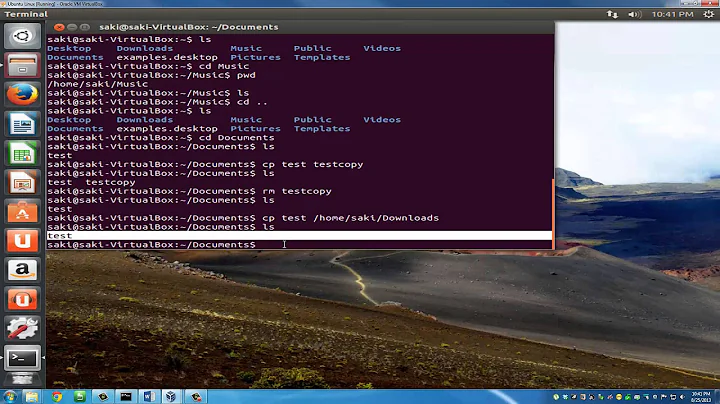Why do we need the "at" command in Linux?
Solution 1
Bernhard's reply is correct: in multi-user systems, the ability to execute heavy programs at some ungodly hours of the night is especially convenient, for both the person submitting the job, and his coworkers. It is part of "playing nice".
I did most of my Ph.D. computations this way, combining the script with the nice command which demoted the priority of my work whenever other people were keeping the machine busy, while leaving intact its ability to hog all the system resources at night.
I used the very same command to check whether my program was running, and to restart it if necessary.
Also, you should keep in mind that at was written way before screen, tmux, and so on, so that it was a simple way to have a detached shell, i.e., one that would not die once you logged off the system.
Lastly, you should also notice that it is different from cron, which also has been around for a long time. The difference lies in the fact that at is occasional, while cron, being so repetitive, is more suited for system jobs which really need to be executed forever at fixed intervals: in fact, at gives you your own environment, with your own settings (and choices) of environment variable, while cron uses a minimal set of environment variables (just check the difference in PATH, as an example).
Solution 2
I use the at command when I need to do some heavy processing on data, which I want to have executed during the night, when I am not behind my computer. Of course I could start the process just after I leave, but this is something I tend to forget.
The result of the command is not different from regularly execution of the script or command.
Solution 3
When you have questions such as this always consult the man pages. They can be very enlightening.
What it does
excerpt from at man page
NAME
at, batch, atq, atrm - queue, examine or delete jobs for later execution
DESCRIPTION
at and batch read commands from standard input or a specified file
which are to be executed at a later time, using /bin/sh.
Usage
The usage of the tools:
Usage: at [-V] [-q x] [-f file] [-mldbv] timespec ...
at [-V] [-q x] [-f file] [-mldbv] -t time
at -c job ...
atq [-V] [-q x]
atrm [-V] job ...
batch
at includes 4 commands (at, atq, atrm, and batch). You use at and batch to schedule the jobs, atq to see what's scheduled, and atrm to remove a job prior to it running.
$ at -f <cmd> timspec
Timespec
The time to run the at job can be specified in different ways.
excerpt form at man page
At allows fairly complex time specifications, extending the POSIX.2 standard. It accepts times of the form HH:MM to run a job at a specific time of day. (If that time is already past, the next day is assumed.) You may also specify mid‐ night, noon, or teatime (4pm) and you can have a time-of-day suffixed with AM or PM for running in the morning or the evening. You can also say what day the job will be run, by giving a date in the form month-name day with an optional year, or giving a date of the form MMDD[CC]YY, MM/DD/[CC]YY, DD.MM.[CC]YY or [CC]YY-MM-DD. The specification of a date must follow the specification of the time of day. You can also give times like now + count time-units, where the time- units can be minutes, hours, days, or weeks and you can tell at to run the job today by suffixing the time with today and to run the job tomorrow by suffixing the time with tomorrow.
Examples
Say you have this shell script.
$ cat mycrontest.sh
#!/bin/bash
echo "It is now $(date +%T) on $(date +%A)"
Sample run:
$ ./mycrontest.sh
It is now 18:37:42 on Friday
Sample at job submissions:
$ at -f mycrontest.sh 10pm tomorrow
job 14 at Sun Jul 8 22:00:00 2007
$ at -f mycrontest.sh 2:00 tuesday
job 15 at Tue Jul 10 02:00:00 2007
$ at -f mycrontest.sh 2:00 july 11
job 16 at Wed Jul 11 02:00:00 2007
$ at -f mycrontest.sh 2:00 next week
job 17 at Sat Jul 14 02:00:00 2007
References
Solution 4
Your network administrator informs you that some maintenance will occur to your web servers starting at 7pm and finishing by 2am. You want to serve a maintenance notification beforehand, and you want maximum uptime from your system. Are you going to stay up all night, ready to run various commands, and then start it up again later? No, you'd want to use at to schedule these tasks, then go to bed / play skyrim and forget about it.
Solution 5
You can execute batch jobs in UNIX / Linux using any one of the three commands — at, batch or cron.
Schedule an at job using specific date and time
Syntax:
$ at time date
For example, to schedule a job at 11 am on May 20, use the following at command.
$ at 11 am may 20
Related videos on Youtube
BioGenX
C/c++ programmer, currently a professional Software Engineer in Pune, India. Interested in Virtualization, SDN, Cloud, Linux, Networking. Computer networking. I am an OpenStack Enthusiast. My favorite programming language is C and lately developed love for Python. Would also love to increase my hands on experience with Bash scripting. Most of the time I browse for interesting topics on Stackoverflow.
Updated on September 18, 2022Comments
-
BioGenX almost 2 years
I was studying code in which the
atcommand is used. I looked around and found that it is used to execute batch jobs. It is used to schedule jobs. It is given, as its input, a command, and a time, relative or absolute.So, my first question is: why is the
atcommand used? Under which circumstances does one need to useat? I have encountered it when there was some bash script code trying to uninstall software and when some background services were to be restarted.My second question: What is the difference between having any command executed as a batch job and having a command executed in calling command directly (or in subshell)?
-
Carlos Campderrós over 10 yearsAlso worth pointing out as another difference with cron, is that
atretains your environment the way it was when the job was scheduled: same working directory, environment variables, ... -
 Ulrich Schwarz over 10 yearsThere's also
Ulrich Schwarz over 10 yearsThere's alsobatch, which is nearly identical toat, but will wait for a low load instead, and apparently,at -q zwill nice the job by itself, whereasat -q Zwill wait for the time, then wait for load to drop, and nice the job as well. Wow, what a load of seldom-used features! -
BioGenX over 10 yearsYes, I have that understanding of "at" and its usage. Other people have answered it more relevantly.
-
 Hashim Aziz almost 6 yearsI seem to have a very different version of
Hashim Aziz almost 6 yearsI seem to have a very different version ofatavailable on my Cygwin installation - it doesn't seem linked tobatch, no short options at all are supported, there is no quiet option, and nomanorinfopages are included. -
 slm almost 6 years@Hashim - cygwin is it's own beast.
slm almost 6 years@Hashim - cygwin is it's own beast. -
David G. almost 4 yearsWhile it is nice to point out the difference from
cron, it is also good to point out thatat(andbatch) are (or were) actually part ofcron




